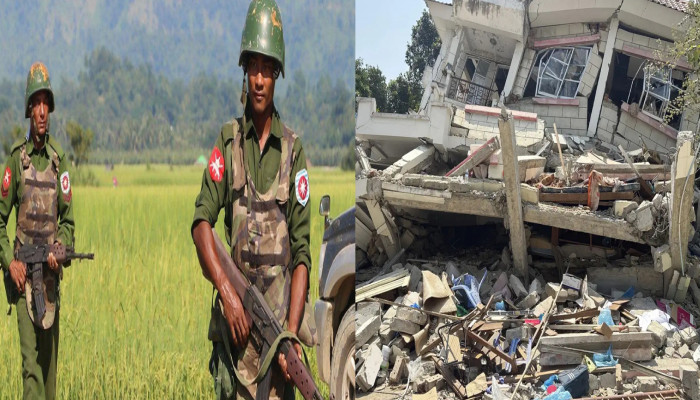Myanmar's army announces ceasefire for quake relief as death toll rises to 3,000
- In Reports
- 11:49 AM, Apr 03, 2025
- Myind Staff
Myanmar’s military government has announced a temporary ceasefire to help with relief efforts after a powerful 7.7 magnitude earthquake killed over 3,000 people. The unexpected announcement was made on Wednesday night through state TV, MRTV. Military leaders, who also control the government, said the ceasefire would last until April 22 as a gesture of compassion for those affected by the disaster. The statement came after armed resistance organisations opposed to military authority unilaterally declared temporary ceasefires. The military threatened to take "necessary" action against the groups if they did not stop attacking the state and reorganising. The resistance forces have stated that they will fight in self-defence if necessary.
Earlier on Wednesday, rescue teams saved two men from the rubble of a hotel in Myanmar's capital. Another person was rescued from a guesthouse in a different city, and one more was found alive in Mandalay, the country's second-largest city, five days after the earthquake. However, most rescue teams were recovering bodies rather than survivors. A powerful earthquake struck at midday on Friday, causing thousands of buildings to collapse, bridges to fall, and roads to crack. By Wednesday, the death toll had risen to 3,085, with over 4,715 people injured, according to MRTV. However, local reports indicate the actual numbers may be even higher. This disaster has worsened Myanmar's already severe humanitarian crisis caused by its ongoing civil war. Even before the earthquake, more than 3 million people had been displaced, and nearly 20 million were in urgent need of assistance, according to the United Nations.
The earthquake also affected neighboring Thailand, causing a high-rise building under construction in Bangkok to collapse. One body was recovered from the debris early Wednesday, bringing the death toll in Bangkok to 22. Additionally, 35 people were injured, most of them at the construction site. Myanmar's military took control in 2021, removing the elected government led by Aung San Suu Kyi. This led to strong-armed resistance. Earlier this week, ceasefires were announced by two groups: the People's Defense Force, which is the armed wing of the opposition’s National Unity Government, and the Three Brotherhood Alliance, a group of three ethnic minority armies.
According to Morgan Michaels, an analyst in Singapore with the International Institute of Strategic Studies, these ceasefires increased pressure on the military government to do the same. "It's too early to say whether a pause in fighting could lead to something longer lasting, he said. It would require very deft and active diplomacy to transform a humanitarian pause into something more lasting. And that's not guaranteed," Morgan said. The military government was especially sensitive to bad publicity this week because its leader, Senior Gen. Min Aung Hlaing, was set to attend a major regional conference in Thailand's capital on Thursday.
This will be his first visit to a country outside of his main allies—China, Russia, and Russia’s close partner, Belarus—since he last attended a regional meeting in Indonesia in 2021. Many Western countries have sanctioned and isolated Min Aung Hlaing and other top officials due to their 2021 military takeover and human rights violations as they try to suppress opposition to their rule. Before the ceasefire was announced on Wednesday, a militia from the Brotherhood Alliance accused the military of attacking a relief convoy on Tuesday night in northern Shan state. The convoy consisted of nine vehicles from the Chinese Red Cross, which was delivering supplies to Mandalay. The Ta'ang National Liberation Army stated that the convoy had informed the military about its route in advance. However, the military government’s spokesman, Maj. Gen. Zaw Min Tun denied this, saying the convoy had not notified authorities. According to state media MRTV, he did not mention the Red Cross but claimed security forces fired warning shots because the convoy refused to stop.
Chinese Foreign Ministry spokesperson Guo Jiakun did not comment on the attack. The International Federation of Red Cross and Red Crescent Societies is currently investigating the situation. Many countries have pledged millions of dollars to support Myanmar and aid organisations in their massive relief efforts. They are also sending expert search and rescue teams and setting up temporary hospitals.
India and China, Myanmar’s neighboring countries that often compete for influence, have been particularly quick and generous in offering help. Other nations, including Turkey, Vietnam, Singapore, and Malaysia, have also sent teams. The US government has committed $2 million in emergency aid and has sent a three-person team to assess how best to provide support despite recent reductions in US foreign aid. United Nations spokesman Stephane Dujarric said that ongoing aftershocks are making it harder to provide help. In Mandalay City, many people have no electricity or running water.
Those affected urgently need medical care, supplies, clean drinking water, food, and other essentials, Dujarric said. They also need tents, temporary shelters, toilets, and hygiene products to prevent diseases from spreading. Most of the information so far, is from Mandalay, which was close to the earthquake's epicentre, and Naypyitaw, located about 270 kilometers (165 miles) north of Mandalay. Many areas have no electricity, telephone, or cellphone connections, and roads are difficult to access.
In Singu township, about 65 kilometers (40 miles) north of Mandalay, a cave-in at a gold mine killed 27 miners, according to the independent Democratic Voice of Burma. At Inle Lake, a well-known tourist spot northeast of the capital, many people lost their lives when houses built on wooden stilts in the water collapsed during the earthquake, as reported by the Global New Light of Myanmar.







Comments